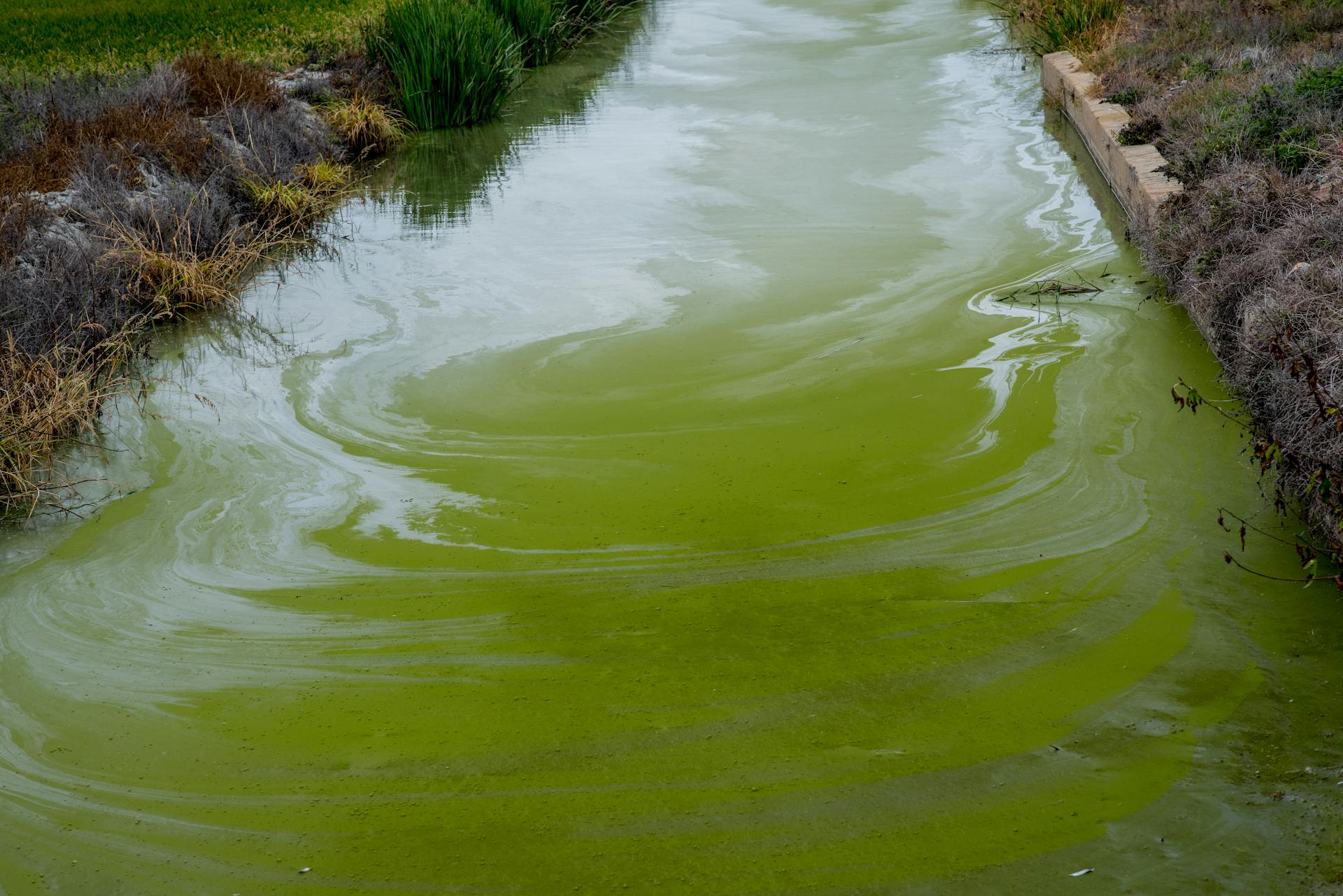
As summer approaches, many dog owners will be eager to spend more time outdoors with their furry friends. However, it's essential to be aware of the dangers of dog algae poison, a potentially life-threatening condition that can occur when dogs ingest algae from contaminated water.
Dogs are particularly susceptible to algae poisoning due to their instinct to drink from standing water, which can be a breeding ground for toxic algae. In fact, studies have shown that dogs are more likely to contract algae poisoning than humans.
To prevent algae poisoning, it's crucial to keep your dog away from standing water and to regularly inspect their surroundings for signs of algae growth.
Causes and Effects
Dog algae poison, also known as blue-green algae, is a toxic substance that can be found in stagnant water bodies.
It's produced by certain types of bacteria, such as Anabaena and Microcystis, which thrive in warm and nutrient-rich waters.
These bacteria can produce toxins that are up to 100 times more potent than cyanide.
The most common cause of dog algae poisoning is drinking water that contains these toxins.
This can happen when dogs swim in or drink from contaminated water sources, such as lakes, rivers, or ponds.
The effects of dog algae poisoning can be severe and even fatal.
Symptoms can include vomiting, diarrhea, abdominal pain, and even liver failure.
In severe cases, dogs can die within 15 minutes of ingesting the toxin.
If you suspect your dog has ingested blue-green algae, it's essential to seek veterinary attention immediately.
Symptoms and Treatment
Symptoms of dog algae poisoning can develop rapidly and are often life-threatening. If your dog is exposed to blue-green algae, get to a veterinary clinic as fast as possible.
Clinical signs may include vomiting, diarrhea, drooling, redness and blisters on the skin, muscle tremors, muscle rigidity, seizures, inability to walk, difficulty breathing, weakness, and even death.
Some symptoms of algae blooms toxicity in dogs include vomiting, diarrhea, dark urine, blood in stool or black, tarry stool, elevated liver enzymes, liver damage, stumbling, seizures, disorientation, increased heart rate, incoordination, labored breathing, muscle tremors, muscle rigidity, lethargy, paralysis, drooling, and pain.
The toxins in algae blooms can attack the body rapidly, so prompt diagnosis and treatment is essential for your dog's survival. The veterinary team may treat your dog with intravenous fluids, electrolytes, and anti-seizure medication, and may also give them activated charcoal.
Here are some common symptoms of dog algae poisoning:
- Vomiting
- Diarrhea
- Drooling
- Reddening of the skin
- Blisters of the skin
- Muscle tremors
- Muscle rigidity
- Seizures
- Inability to walk
- Difficulty breathing
- Weakness
- Death
Treatment of Blooms
The toxins from algae blooms attack the body rapidly, making prompt diagnosis and treatment essential for your dog's survival.
Your veterinarian will treat your dog with intravenous fluids to help flush out the toxins.
Electrolytes will be administered to maintain your dog's delicate balance of fluids and minerals.
Anti-seizure medication may be given to control seizures caused by the toxins.
Activated charcoal can also be given to help absorb the toxins in your dog's stomach.
Your dog will need to be hospitalized for 24/7 intensive care to ensure they receive the best possible treatment.
A unique perspective: Dog Rat Poison Treatment
Symptoms

Symptoms can develop rapidly or over several hours, and may include any of the following:
Vomiting is a common symptom of blue-green algae poisoning in dogs.
Diarrhea is also a frequent symptom, often accompanied by vomiting.
Dark urine, blood in stool or black, tarry stool, and elevated liver enzymes can occur due to liver damage.
Stumbling, seizures, disorientation, increased heart rate, incoordination, labored breathing, muscle tremors, and muscle rigidity are all possible symptoms.
Here's a breakdown of the symptoms:
- Vomiting
- Diarrhea
- Dark urine, blood in stool, or black, tarry stool
- Elevated liver enzymes
- Stumbling
- Seizures
- Disorientation
- Increased heart rate
- Incoordination
- Labored breathing
- Muscle tremors
- Muscle rigidity
- Lethargy
- Paralysis
- Drooling
Keep in mind that the symptoms can vary depending on the specific toxins present in the water. If you suspect your dog has been exposed to blue-green algae, it's essential to seek veterinary care as soon as possible.
Prevention and Safety
To keep your dog safe from algae poisoning, it's crucial to be aware of the risks. Algal blooms can occur in fresh water, such as ponds and lakes, and in brackish water, like where a river meets an ocean.
Visible algal blooms or warning signs are a clear indication that a harmful bloom is present. These signs can be found in areas where your dog may be playing or swimming.
If you notice an algal bloom, it's best to keep your dog away from it and report it to the environmental health section of your local health department.
On a similar theme: Poison Dog Signs
Keeping Your Dog Safe and Healthy This Summer
Summer is here, and it's time to get outside with your furry friend. Knowing how to keep your dog safe from toxic algae is crucial for a fun and worry-free adventure.
Toxic algae can be seriously harmful to dogs and people, even in small amounts, the size of a 50 cent piece. So, it's essential to be aware of its presence.
If you're planning a trip to the river or lake, keep an eye out for visible algal blooms or warning signs indicating a harmful bloom is present. Algal blooms can occur in fresh water, such as ponds and lakes, and in brackish water, such as where a river meets an ocean.
Warmer temperatures increase the likelihood of algal blooms, making summer a prime time for exposure. However, toxins have been detected year-round, so vigilance is necessary.
Keeping your dog in a harness when they're in or near an open body of water will allow you to gently pull them back from any suspicious plant material. This simple precaution can save your dog from potential harm.
Recovery of Blooms
Recovery from algae blooms toxicity in dogs is a serious matter. Prompt diagnosis and treatment is essential for survival.
The recovery prognosis is very grave. Dogs that do recover may suffer repercussions due to the poisoning incident.
Your dog will need to be hospitalized to provide him with 24/7 intensive care. This is crucial for his recovery.
Follow-up visits will be necessary to monitor his progress.
Toxicity and Poisoning
Blue-green algae poisoning in dogs is a serious issue that can be fatal within minutes to hours. It's essential to keep your dog away from water with visible algal blooms.
The toxins produced by blue-green algae can affect a dog's liver, neurologic system, or skin. If the toxin affects the liver, it can cause liver failure within just a few hours.
If your dog drinks or swims in water with toxic blue-green algae, the various toxins produced can cause clinical signs such as tremors, seizures, and skin blisters. These signs can develop quickly, and exposure is usually fatal.
Dogs exposed to the toxin that affects only the skin usually survive, but treatment is still needed. They may require topical ointments, topical antibiotics, or oral antibiotics to treat their blisters.
The best way to keep your dog safe is by keeping them away from water with visible algal blooms. Algal blooms can occur in fresh water, such as ponds and lakes, and in brackish water, such as where a river meets an ocean.
Prompt diagnosis and treatment is essential for the survival of your dog. The veterinary team will treat your dog with intravenous fluids, electrolytes, and anti-seizure medication.
Toxic algae are naturally occurring in rivers and lakes, including waterways with good water quality. Most algae are harmless, but some types of algae can produce toxins that are harmful to humans and animals.
Dogs are particularly susceptible to poisoning from toxic algae as they can be attracted to its musty smell. Dogs' deaths have been reported from sites where toxic algae have been present in small amounts.
The toxins attack the body rapidly, so prompt treatment is crucial. Your dog will need to be hospitalized to provide him with 24/7 intensive care.
Sources
- https://www.vet.cornell.edu/departments-centers-and-institutes/riney-canine-health-center/canine-health-information/blue-green-algae-poisoning-cyanobacteria-toxicosis
- https://animalemergencycare.net/when-water-is-dangerous-algae-poisoning-in-pets/
- https://www.petmd.com/dog/poisoning/how-to-identify-blue-green-algae-for-dogs
- https://wagwalking.com/condition/algae-blooms-toxicity
- https://www.lawa.org.nz/learn/factsheets/keeping-your-dog-safe-from-toxic-algae/
Featured Images: pexels.com


